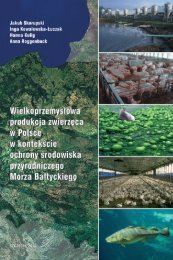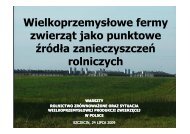best available technologies for manure treatment - Baltic Green Belt
best available technologies for manure treatment - Baltic Green Belt
best available technologies for manure treatment - Baltic Green Belt
Create successful ePaper yourself
Turn your PDF publications into a flip-book with our unique Google optimized e-Paper software.
Best Available Technologies <strong>for</strong> <strong>manure</strong> <strong>treatment</strong> baltic sea 2020<br />
Best Available Technologies <strong>for</strong> <strong>manure</strong> <strong>treatment</strong> baltic sea 2020<br />
ANNEX E: TABLES WITH SHORT DESPRIPTION OF LIVESTOCK MANURE TREATMENT TECHNOLOGIES<br />
Best Available Techniques <strong>for</strong> <strong>manure</strong> <strong>treatment</strong> - <strong>for</strong> intensive rearing of pigs in <strong>Baltic</strong> Sea Region EU Member States Technical Report "Best Practice Manure Handling, Phase 2"<br />
Ref No. 41A Composting of liquid livestock <strong>manure</strong><br />
Brief description Description of the effect on leaching (positive or negative) of N and P<br />
On some installations <strong>for</strong> the intensive rearing of pigs, aerobic <strong>treatment</strong> is used to reduce odour<br />
emissions from pig slurry and, in some cases, to reduce its N content. Liquid <strong>manure</strong> is composted by<br />
means of aeration (liquid composting) or by mixing it with an adequate amount of litter. The mixture<br />
can then be composted in a stack or drum. In aeration, aerobic <strong>treatment</strong> is used to improve the<br />
properties of liquid <strong>manure</strong> without drying and solidifying the <strong>manure</strong>. Manure contains large<br />
quantities of nutrients <strong>for</strong> plants and micro-organisms, as well as microbes that are capable of<br />
utilising these nutrients. The air conducted into liquid <strong>manure</strong> starts aerobic decomposition, which<br />
produces heat, and as a result of the aeration bacteria and fungi which use oxygen in their<br />
metabolism multiply. The main products from the activity of micro-organisms are carbon dioxide,<br />
water and heat.<br />
Designs are site-specific and take into account loading rate and the time treated slurry needs to be<br />
stored be<strong>for</strong>e being applied to land. Such systems may include the use of mechanical separators.<br />
(France, particularly Brittany, has some <strong>treatment</strong> plants <strong>for</strong> reducing N and P, while many countries<br />
have a few examples of aerobic <strong>treatment</strong> <strong>for</strong> reducing odour e.g. Germany, Italy, Portugal and the<br />
UK). Aeration is also applied to prepare slurry <strong>for</strong> it to be used to flush gutters, tubes or canals under<br />
slatted floors.<br />
See the description <strong>for</strong> composting.<br />
It is a risk <strong>for</strong> any of the aeration <strong>technologies</strong>, especially <strong>for</strong><br />
nitrification-denitrification, that there are <strong>for</strong>med laughing gas,<br />
N<br />
2<br />
O, in connection with the aeration and the conversion of N that<br />
is accelerated due to that.<br />
The long lifetime (150 years) of laughing gas, N<br />
2<br />
O, in the<br />
atmosphere contributes to its large radiative-<strong>for</strong>cing potential,<br />
which is 310 times that of carbon dioxide (CO<br />
2<br />
).<br />
Innovation stage<br />
Investment price, <br />
Basic Variable<br />
Operational<br />
costs,<br />
per tonnes<br />
per kg saved N or<br />
P leaching<br />
Complexity of implementation<br />
Research<br />
Pilot<br />
Practice <br />
For a composting plant that treats 2,000 tonnes<br />
<strong>manure</strong> with 1,360 tonnes sawdust and producing<br />
1,800 tonnes compost:<br />
For a turned windrow system, an appropriate<br />
tractor and turner could easily cost 35,000<br />
to 40,000.<br />
If buildings are constructed <strong>for</strong> all four<br />
activities (mixing, composting, curing and<br />
storage), total construction costs could be <br />
82,000 to 100,000 <strong>for</strong> an operation of this<br />
size.<br />
No data<br />
Around 20 as<br />
an average,<br />
depending on the<br />
efficiency.<br />
Major references Condition <strong>for</strong> leaching reduction effect Certainty of in<strong>for</strong>mation<br />
The question<br />
cannot be answered<br />
because there is a<br />
negative effect on<br />
the leaching.<br />
Composting can be organised on<br />
every farm, however, there exists<br />
more advanced and industrial<br />
composting <strong>technologies</strong>, which<br />
probably have a large economy of<br />
scale.<br />
Ministry of Agriculture,<br />
Food and Fisheries.<br />
1996<br />
Barrington et al., 2002<br />
Composting has no leaching reduction effect – on<br />
the contrary, the process itself is often reason <strong>for</strong><br />
leaching.<br />
Prices Low<br />
Effect on leaching High<br />
65<br />
Side 66<br />
65








